Kesko Bundle
How Does Kesko Dominate the Northern European Retail Landscape?
Founded in 1940, Kesko has transformed from a Finnish cooperative to a retail powerhouse. Its journey showcases a dynamic Kesko SWOT Analysis, with a sales and marketing strategy that has been key to its success. This analysis dives deep into how Kesko adapts to evolving consumer behaviors and market dynamics.
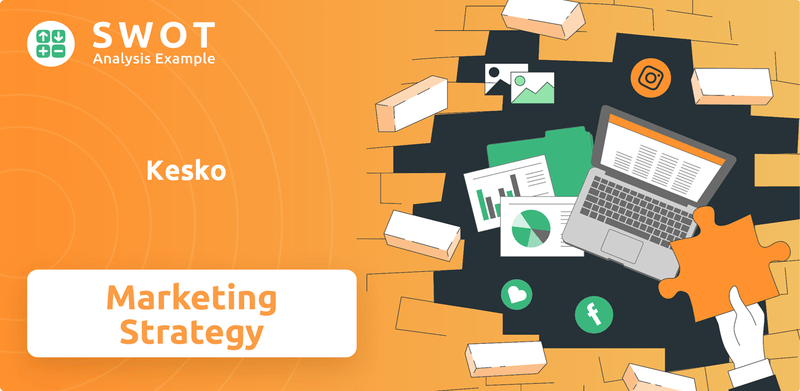
Kesko's commitment to digital transformation and sustainability has significantly reshaped its market position and reputation. This exploration will dissect Kesko's sales strategy and marketing strategy, revealing how it leverages customer loyalty, digital services, and strategic brand positioning. Understanding Kesko's approach offers valuable insights for anyone interested in Kesko company analysis and the nuances of modern retail.
How Does Kesko Reach Its Customers?
The sales channels employed by Kesko are a critical component of its overall Kesko sales strategy, designed to maximize customer reach and drive revenue across its diverse business segments. This strategy integrates both physical and digital channels, reflecting a commitment to meeting evolving consumer preferences and market dynamics. Kesko's approach aims for an omnichannel experience, ensuring customers can interact with the company seamlessly across various touchpoints.
Kesko's multifaceted approach to sales channels includes an extensive network of physical retail locations, particularly the K-Group stores in Finland, which encompass grocery, building and technical, and car trade divisions. Complementing its physical presence, Kesko has invested heavily in e-commerce platforms, such as K-Ruoka.fi and K-Rauta.fi, to provide online shopping options. This strategic integration of online and offline channels supports Kesko's Kesko marketing strategy, ensuring a broad customer reach.
The company's Kesko business model leverages a combination of direct retail, wholesale distribution, and strategic partnerships to enhance market penetration. This includes the use of wholesale distributors like Onninen, which serves professional customers in the building and technical trade. The continuous optimization of this channel mix, with a strong emphasis on digital growth and omnichannel synergy, is central to Kesko's sales strategy, contributing to its Kesko financial performance.
The cornerstone of Kesko's offline presence is its extensive network of physical retail locations. These include K-Citymarket, K-Supermarket, and K-Market for groceries, and K-Rauta for building and home improvement. These stores provide personalized shopping experiences and local accessibility, serving as crucial touchpoints for customers.
Kesko has significantly expanded its e-commerce platforms to meet the growing demand for online shopping. Company websites like K-Ruoka.fi and K-Rauta.fi offer a wide assortment of products, click-and-collect services, and home delivery options. Online sales have been a strategic imperative, contributing to overall sales performance.
Kesko's sales strategy emphasizes omnichannel integration to provide a seamless customer experience across all touchpoints. This allows customers to browse products online, check stock availability, and place orders for in-store pickup or home delivery. This integration ensures customers can interact with Kesko through their preferred channel.
Kesko leverages wholesale distributors and partner retailers, particularly in its building and technical trade division, to reach B2B customers. Onninen, for example, operates as a wholesale distributor serving professional customers. Strategic partnerships likely enhance product offerings and market reach.
Kesko's sales channels are designed to reach a broad customer base and drive sales growth. The strategy involves a blend of physical stores, e-commerce platforms, wholesale distribution, and strategic partnerships. This integrated approach supports Kesko's market position and allows it to adapt to changing market conditions.
- Extensive Retail Network: K-Group stores provide a strong physical presence.
- E-commerce Expansion: Online platforms offer convenience and wider product access.
- Omnichannel Experience: Seamless integration of online and offline channels.
- Strategic Partnerships: Wholesale and partner networks expand market reach.
Kesko SWOT Analysis
- Complete SWOT Breakdown
- Fully Customizable
- Editable in Excel & Word
- Professional Formatting
- Investor-Ready Format
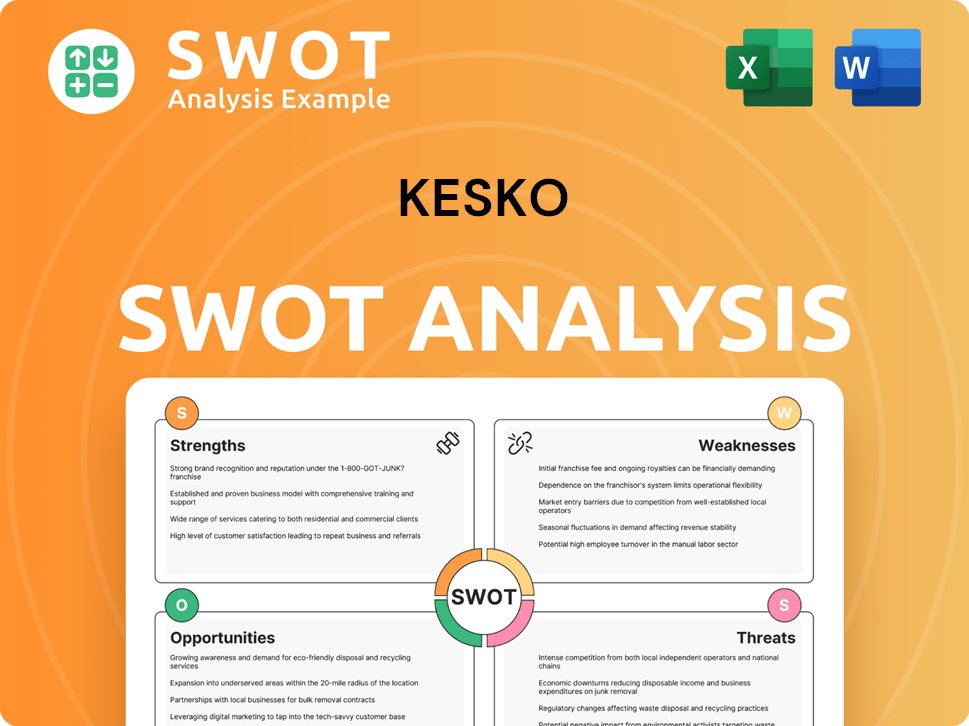
What Marketing Tactics Does Kesko Use?
The marketing tactics of Kesko are designed to boost brand awareness, generate leads, and drive sales across its various business segments. A key element of the Kesko marketing strategy involves a blend of digital and traditional marketing methods. This approach ensures a broad reach and targeted engagement with different customer segments.
Kesko leverages a data-driven approach, particularly through its K-Plussa loyalty program, to personalize offers and communications. The company continuously refines its strategies to enhance customer lifetime value, demonstrating a commitment to understanding and meeting customer needs effectively. This commitment is a core element of the Kesko company analysis.
The company's marketing mix has evolved significantly towards digital channels and data-driven personalization. This shift reflects a broader trend in the retail sector, where companies are increasingly focused on leveraging data and technology to improve customer engagement and drive sales. For a deeper understanding of the competitive environment, see the Competitors Landscape of Kesko.
Digital marketing is a cornerstone of Kesko's strategy, with content marketing, paid advertising, and email marketing playing vital roles. Content marketing includes recipes, DIY guides, and articles on sustainable living. Paid advertising is used to target specific customer segments.
Content marketing is a key element of Kesko's digital strategy, producing valuable content such as recipes on K-Ruoka.fi and DIY guides on K-Rauta.fi. This content not only engages customers but also improves search engine optimization (SEO). This approach helps to drive organic traffic and increase brand visibility.
Paid advertising, including search engine marketing (SEM) and display advertising, is strategically employed to target specific customer segments. These campaigns are often used to promote seasonal campaigns or new product launches, ensuring that the right message reaches the right audience at the right time.
Email marketing is a core component of Kesko's customer relationship management, delivering personalized offers, loyalty program benefits, and relevant content directly to subscribers. This approach leverages data from its K-Plussa loyalty program to tailor communications and improve customer engagement.
Social media platforms like Facebook, Instagram, and LinkedIn are actively used for community engagement and brand building. The company creates tailored content for each platform, promoting campaigns and fostering direct interaction with customers. This helps to build a strong online presence.
Kesko incorporates traditional media channels such as TV, radio, and print advertisements, particularly for broad-reach campaigns during key retail seasons. This ensures that the company reaches a wide audience, complementing its digital efforts. These campaigns are often timed to coincide with major retail events.
Kesko's approach to data-driven marketing is highly sophisticated, leveraging the extensive data collected through its K-Plussa loyalty program, which boasts millions of members. This data enables granular customer segmentation and personalization of offers, communications, and product recommendations.
- Customer Segmentation: Kesko uses data to divide customers into specific groups based on their behaviors and preferences.
- Personalized Offers: Tailored promotions and discounts are offered to individual customers based on their purchase history and interests.
- Communication Customization: Marketing messages are personalized to resonate with specific customer segments.
- Product Recommendations: Customers receive product suggestions based on their past purchases and browsing activity.
Kesko PESTLE Analysis
- Covers All 6 PESTLE Categories
- No Research Needed – Save Hours of Work
- Built by Experts, Trusted by Consultants
- Instant Download, Ready to Use
- 100% Editable, Fully Customizable
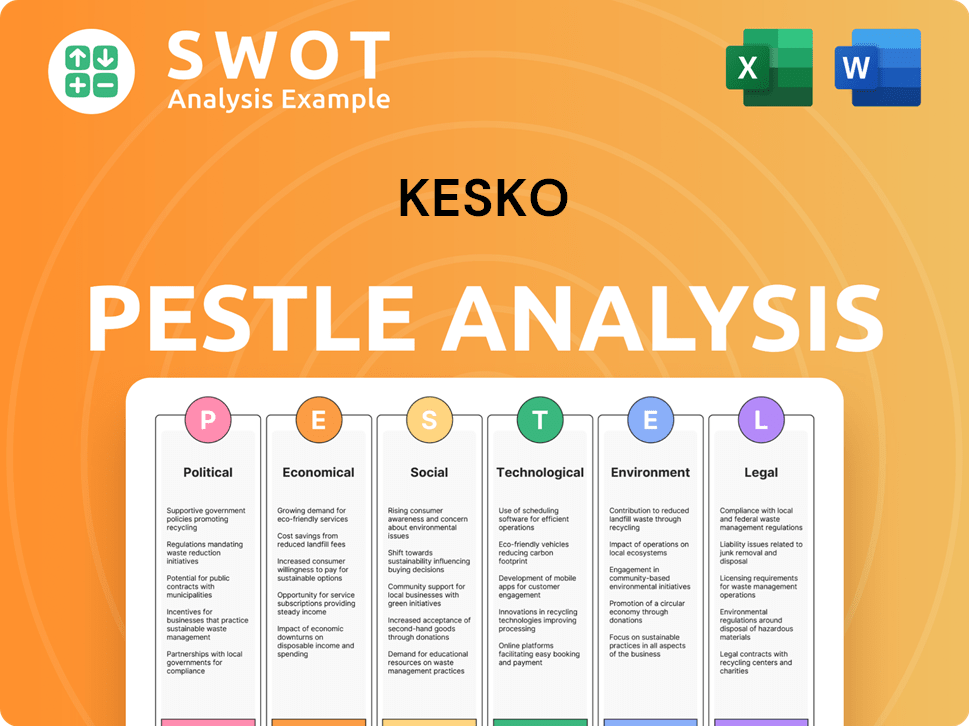
How Is Kesko Positioned in the Market?
The brand positioning of Kesko is centered on delivering quality, convenience, and value across its diverse retail operations. This strategy is consistently applied across its various brands, including those in grocery, home improvement, and car dealerships. The core message emphasizes being a reliable partner for customers' daily needs, home projects, and professional requirements.
Kesko's visual identity, particularly the 'K' logo, is instantly recognizable throughout Finland and other operating countries. The company's tone of voice is customer-centric, aiming to build long-term relationships. Kesko promises a seamless customer experience, both in-store and online, focusing on product availability, service quality, and ease of shopping. This approach supports its overall Revenue Streams & Business Model of Kesko.
Kesko's brand strategy is designed to resonate with its target audience through various channels. For grocery retail, the focus is on freshness, variety, and competitive pricing. Building and home improvement emphasizes expertise and comprehensive product ranges. Car dealerships highlight reliability and service. A key differentiator is Kesko's commitment to sustainability, with targets for carbon neutrality in its own operations by 2025 and across its value chain by 2030.
The Kesko sales strategy focuses on providing a seamless customer experience across all channels. This includes a strong emphasis on product availability, service quality, and ease of shopping. The company leverages its widespread store network and growing online delivery services to enhance customer convenience.
The Kesko marketing strategy is built on a foundation of quality, convenience, and value. The company uses a multi-pronged approach to appeal to different customer segments. Sustainability is a key focus, with marketing efforts highlighting environmental initiatives and responsible sourcing practices.
Kesko maintains brand consistency across all channels. This includes in-store signage, product packaging, digital interfaces, and marketing communications. The consistent messaging helps reinforce brand recognition and trust among consumers.
Kesko's approach is customer-centric, aiming to build long-term relationships. The company actively monitors consumer sentiment and adapts its brand messaging to stay relevant. This customer focus supports its market position and financial performance.
Kesko's strategic focus for 2024-2025 includes enhancing its online sales strategy and expanding its sustainable marketing initiatives. The company is also likely to explore strategic partnerships to strengthen its market position.
- Digital Transformation: Investing in digital channels to improve customer experience and drive online sales growth.
- Sustainability Initiatives: Expanding sustainable product offerings and promoting environmentally friendly practices.
- Market Expansion: Exploring opportunities for international expansion and strategic partnerships.
- Customer Relationship Management: Implementing CRM strategies to enhance customer loyalty and engagement.
Kesko Business Model Canvas
- Complete 9-Block Business Model Canvas
- Effortlessly Communicate Your Business Strategy
- Investor-Ready BMC Format
- 100% Editable and Customizable
- Clear and Structured Layout
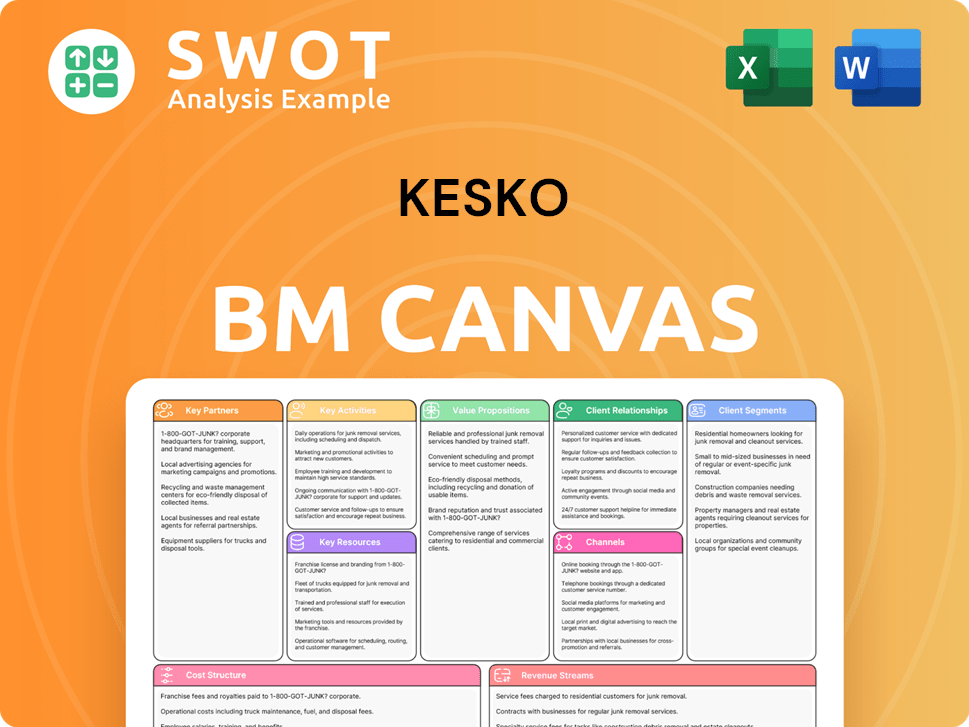
What Are Kesko’s Most Notable Campaigns?
Kesko's sales and marketing strategies are multifaceted, focusing on value, convenience, sustainability, and community engagement. These strategies are often implemented through various campaigns, including seasonal promotions and digital initiatives. The company leverages its K-Plussa loyalty program to personalize offers and enhance customer engagement. A thorough Kesko company analysis reveals a commitment to adapting to evolving consumer preferences and market trends.
The company's approach includes a blend of traditional and digital marketing channels. This omnichannel strategy aims to reach a broad audience and drive sales across physical stores and online platforms. Kesko's campaigns are designed to increase foot traffic, boost online sales, and strengthen brand loyalty. The Kesko marketing strategy also places a strong emphasis on sustainability and healthy living.
Campaigns are regularly updated to reflect current market conditions and consumer demands. The company consistently monitors and analyzes campaign performance to optimize strategies and maximize effectiveness. This data-driven approach ensures that marketing efforts are targeted and efficient, contributing to overall business growth and market share. For more details, see the Growth Strategy of Kesko.
Seasonal campaigns, such as those around Christmas and Easter, are key drivers of sales. These campaigns feature themed promotions, product bundles, and personalized offers for K-Plussa members. They aim to increase footfall in stores and boost online sales. In 2024, these campaigns likely continued to be a significant part of the Kesko sales strategy.
Focus on promoting digital services, including e-commerce platforms and mobile applications. These campaigns drive digital adoption and highlight the convenience of online shopping. They often include calls to action for downloading apps and visiting online stores. The Kesko digital marketing strategy examples are crucial for adapting to changing consumer behavior.
Campaigns promoting locally sourced products, organic options, and reduced food waste are increasingly important. These campaigns align with consumer trends and reinforce Kesko's responsible brand positioning. They often include informative content and partnerships with local producers. These Kesko sustainable marketing initiatives are a key element.
The K-Plussa loyalty program is central to many campaigns, offering personalized promotions and enhanced customer engagement. This program helps to gather valuable customer data, enabling more targeted and effective marketing efforts. Kesko customer relationship management strategy relies heavily on this program.
Recent campaigns likely incorporate elements such as data-driven personalization, seamless omnichannel integration, and clear messaging. These elements help to ensure that marketing efforts resonate with the target audience. The focus is on creating meaningful customer experiences and driving sales growth. Kesko market position is strengthened through these efforts.
- Data-driven personalization for targeted offers.
- Seamless integration across online and offline channels.
- Clear and impactful messaging to resonate with consumers.
- Emphasis on sustainability and healthy living.
Kesko Porter's Five Forces Analysis
- Covers All 5 Competitive Forces in Detail
- Structured for Consultants, Students, and Founders
- 100% Editable in Microsoft Word & Excel
- Instant Digital Download – Use Immediately
- Compatible with Mac & PC – Fully Unlocked
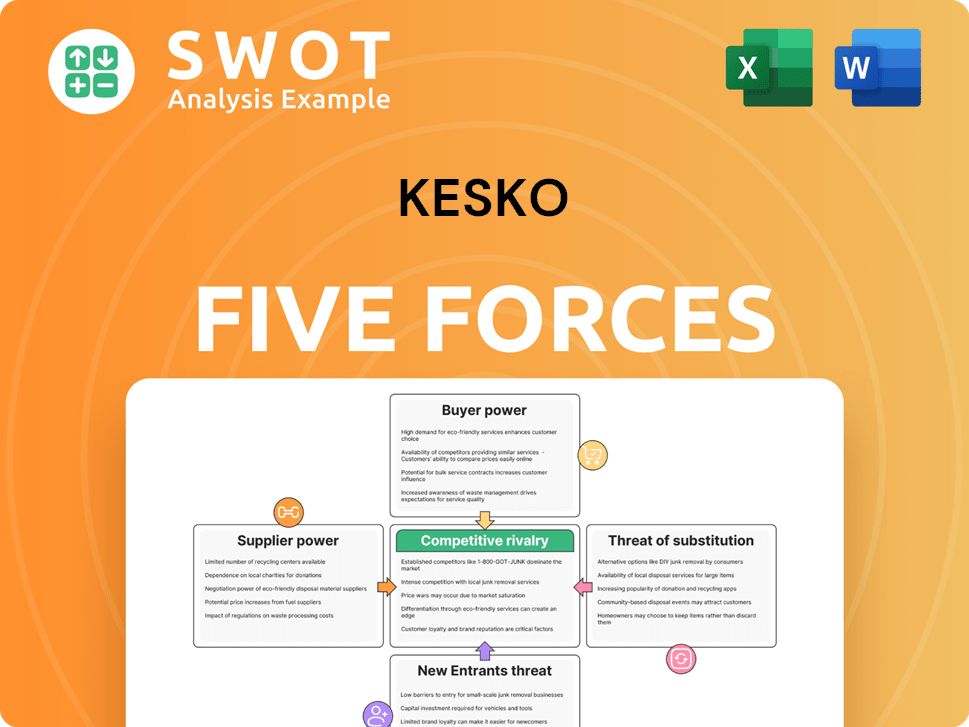
Related Blogs
- What are Mission Vision & Core Values of Kesko Company?
- What is Competitive Landscape of Kesko Company?
- What is Growth Strategy and Future Prospects of Kesko Company?
- How Does Kesko Company Work?
- What is Brief History of Kesko Company?
- Who Owns Kesko Company?
- What is Customer Demographics and Target Market of Kesko Company?
Disclaimer
All information, articles, and product details provided on this website are for general informational and educational purposes only. We do not claim any ownership over, nor do we intend to infringe upon, any trademarks, copyrights, logos, brand names, or other intellectual property mentioned or depicted on this site. Such intellectual property remains the property of its respective owners, and any references here are made solely for identification or informational purposes, without implying any affiliation, endorsement, or partnership.
We make no representations or warranties, express or implied, regarding the accuracy, completeness, or suitability of any content or products presented. Nothing on this website should be construed as legal, tax, investment, financial, medical, or other professional advice. In addition, no part of this site—including articles or product references—constitutes a solicitation, recommendation, endorsement, advertisement, or offer to buy or sell any securities, franchises, or other financial instruments, particularly in jurisdictions where such activity would be unlawful.
All content is of a general nature and may not address the specific circumstances of any individual or entity. It is not a substitute for professional advice or services. Any actions you take based on the information provided here are strictly at your own risk. You accept full responsibility for any decisions or outcomes arising from your use of this website and agree to release us from any liability in connection with your use of, or reliance upon, the content or products found herein.